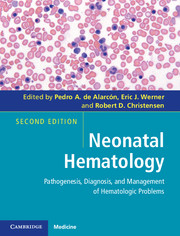Book contents
- Frontmatter
- Contents
- Contributors
- Foreword
- Preface
- 1 A historical review
- Section I Developmental hematology
- Section II Erythrocyte disorders
- 4 Anemia of prematurity and erythropoietin therapy
- 5 Bone marrow failure syndromes
- 6 Hemolytic disease of the fetus and newborn
- 7 Neonatal hemolysis
- 8 Neonatal screening for red blood cell disorders
- 9 Polycythemia and hyperviscosity in the newborn
- Section III Platelet disorders
- Section IV Leukocyte disorders
- Section V Immunologic disorders
- Section VI Hemostatic disorders
- Section VII Transfusional medicine
- Section VIII Miscellaneous
- Index
- Plate section
- References
6 - Hemolytic disease of the fetus and newborn
from Section II - Erythrocyte disorders
Published online by Cambridge University Press: 05 February 2013
- Frontmatter
- Contents
- Contributors
- Foreword
- Preface
- 1 A historical review
- Section I Developmental hematology
- Section II Erythrocyte disorders
- 4 Anemia of prematurity and erythropoietin therapy
- 5 Bone marrow failure syndromes
- 6 Hemolytic disease of the fetus and newborn
- 7 Neonatal hemolysis
- 8 Neonatal screening for red blood cell disorders
- 9 Polycythemia and hyperviscosity in the newborn
- Section III Platelet disorders
- Section IV Leukocyte disorders
- Section V Immunologic disorders
- Section VI Hemostatic disorders
- Section VII Transfusional medicine
- Section VIII Miscellaneous
- Index
- Plate section
- References
Summary
Introduction
Hemolytic disease of the fetus and newborn (HDFN) is the immune-mediated destruction of fetal red blood cells by maternal antibody. HDFN results when the fetal red blood cells express a paternally inherited red blood cell antigen not present on maternal red blood cells. The spectrum of illness ranges from clinically insignificant to the most severe form of a critically ill, anemic, hydropic, and jaundiced infant who may have subcutaneous edema, ascites, pleural effusions, and pericardial effusions.
There is no agreement when HDFN was first recognized. As reviewed by Stockman, Rosse suggested that the marriage of Catherine of Aragon and Henry VIII illustrates the natural history of HDFN (1). Catherine had five children, three boys and one girl dying in utero with only one surviving girl, Mary I, Tudor Queen of England. A clearer description of the disorder came in 1607 with the description of a twin-birth by a French midwife who delivered a hydropic dead child and a twin that died of jaundice – what we now recognize as kernicterus (2). It was the pivotal paper by Dr. Louis K. Diamond in 1932 that clearly identified the development of the maternal antibody in response to the incompatibility of the fetal red cells with maternal red cells even though the Rhesus red cell antigen had not yet been identified. Parallel to the understanding of HDFN, Landsteiner began the process of identification of the red cell antigens at the start of the 20th century, first with the identification of the ABO system and then with the identification of the Rh system (3). He described the development of antibodies against rhesus monkey red cells in rabbits. He suggested that this was a new antigen distinct from the ABO system and called it the Rhesus antigen. This name is now well established in spite of the early controversy, since the antigen identified was a simian antigen related to but not the same as the human antigen.
- Type
- Chapter
- Information
- Neonatal HematologyPathogenesis, Diagnosis, and Management of Hematologic Problems, pp. 65 - 90Publisher: Cambridge University PressPrint publication year: 2013
References
- 2
- Cited by



